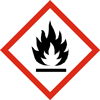안내사항 |
현재 홈페이지에 등록된 제품들은 재고 유무와 관계없이 구입이 가능하며, 별도문의의 상품인 경우 반드시 유선상 확인 후 구매부탁드립니다.
납기가 표기된 상품의 경우 일반적인 수입진행에 소요되는 기간이며, 상품에 따라 납기일정이 추가 될 수 있으니 참고부탁드립니다. |

Thioanisole, 99%
Description
Chemical Properties
· Formula: C7H8S
· Formula weight: 124.21
· Melting Point: -15°
· Boiling Point: 188-189°
· Flash point: 73°(163°F)
· Density: 1.058
· Refractive Index: 1.5860
· Sensitivity: Ambient temperatures.
· Form: Liquid
· Solubility: Miscible with most common organic solvents. Immiscible with water.
Literature References
Monolithiation is thought to occur initially on the ring, but rearrangement then gives the more stable phenylthiomethyllithium: J. Org. Chem., 31, 4097 (1966); Tetrahedron Lett., 1961 (1977). Further metallation occurs at the ortho-position. See, e.g.: Tetrahedron, 46, 861 (1990). Demetallation and acylation is the basis of a route to 3-substituted benzo[b]thiophenes: Synthesis, 888 (1988):

Cation scavenger in the acidic deprotection of peptides; see, e.g.: Int. J. Pept. Prot. Res., 36, 255 (1990). See Appendix 6. The combination of the soft nucleophile thioanisole and the hard acid triflic acid has been used for the cleavage of methyl ethers, e.g. O-methyltyrosine, resistant to other methods: J. Chem. Soc., Chem. Commun., 971 (1979). The same conditions have been used for the cleavage of Cbz, Boc, benzyl and 4-methoxybenzyl protecting groups in peptide synthesis: Chem. Pharm. Bull., 28, 1214 (1980); 29, 600 (1981); J. Chem. Soc., Chem. Commun., 101 (1980); see also: Angew. Chem. Int. Ed., 33, 1729 (1994).
Applications
Thioanisole is used as an intermediate in the preparation of dyes, pharmaceuticals and agrochemicals. It is also used to prepare stable sulfonium salts, sulfoxides and sufones. It is utilized for the cleavage of methyl ethers in association with triflic acid. It acts as a flavoring agent or an adjuvant. It is an important starting material for the synthesis of 3-substituted benzo[b]thiophenes.
Notes
Incompatible with strong oxidizing agents.
Other References:
· Beilstein: 1904179
· UN#: UN3082
GHS Hazard and Precautionary Statements
Hazard Statements : H226-H302-H315-H319-H335
Flammable liquid and vapour.Harmful if swallowed.Causes skin irritation.Causes serious eye irritation.May cause respiratory irritation.
Precautionary Statements : P261-P280f
Avoid breathing dust/fume/gas/mist/vapours/spray.Wear protective clothing.


위험 및 안전 코드
위험 문구 : 22-36/38-43-51/53
Harmful if swallowed.Irritating to eyes and skin.May cause sensitization by skin contact.Toxic to aquatic organisms, may cause long-term adverse effects in the aquatic environment.
안전 문구 : 23-24-26-37-57-60
Do not breathe gas/fumes/vapour/spray (appropriate wording to be specified by the manufacturer).Avoid contact with skin.In case of contact with eyes, rinse immediately with plenty of water and seek medical advice.In case of contact with eyes, rinse immediately with plenty of water and seek medical advice.Use appropriate container to avoid environmental contamination.This material and its container must be disposed of as hazardous waste
· TSCA : 예
· RTECS: DA6200000












